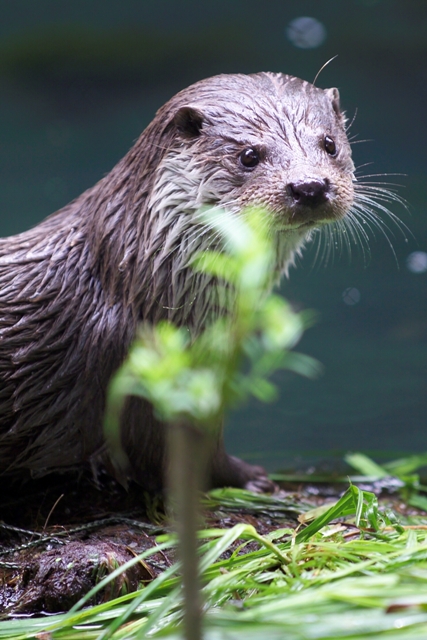Effects of land use change on the population dynamic and distribution of the Eurasian otter (Lutra lutra) in Saxony and Germany
Project management: Dr. Reinhard Klenke
Staff responsible: Dr. Simone Lampa
Funded by: DFG - Deutsche Forschungsgemeinschaft (GZ 1960/2-1)
Project duration: 15. June 2010 - 31. October 2013
Cooperation partners: Prof. Dr. Bernd GruberProf Dr. Klaus Henle Prof Dr. Carsten Dormann Prof Dr. Stefan Halle
Eurasian otter (Lutra lutra) - status
The populations of the otter were tremendously depleted in middle Europe since the end of the 19th century. As a consequence, the population in Germany decreased heavily and in western and middle Germany the otters even disappeared. This led to a distribution gap that disconnects the populations in Eastern and Western Europe. But due to diverse conservation measures otter marks can be found more and more in regions where they were absent for decades. Since the 1990s it can be observed how the otters of central France spread further east and the ones from northeast Germany expand their range towards west, closing the gap this way. Hence, Germany has a high responsibility for the Europe-wide conservation and protection of the otter, especially regarding the reconnection of their habitats.

Eurasian otter (Lutra lutra)
Aim of the project
To comprehend the current spread of the otter and to foster this development with appropriate measures, especially regarding potentially accruing conflicts, we need the knowledge about its population dynamic, preferred habitats and future dispersal routes. For this purpose, we plan to study the population dynamic of the otter by using non-invasive microsatellite genotyping and genetic mark-recapture (genetic CMR) over a sampling period of six years. The study area is located in one of the distribution core area in Germany, in eastern Saxony (Upper Lusatia). With these data we are planning to construct a growth model for the target population and to monitor the population size over the six years through genetic CMR. The derived parameters of the population dynamic are then combined with a landscape habitat model for Saxony to establish a spatio-temporal dispersal model which will be calibrated with the distribution data of the last 60 years. This dispersal model will allow us to predict the prospective dispersal routes, future distribution and impact assessments of land use changes on the dispersal process. The dispersal model for Saxony should then be transferred to Germany using the available distribution and land use data to make predictions about the otter’s future for whole Germany.
Previous work & state of the project
Within the last years the method of the microsatellite genotyping was optimised in our lab as much that the success rate could be duplicated, compared to the first studies in that field (47% versus 20% of Dallas et al.2003), and the error rate could be decreased by 53% (Lampa et al. 2008). This previous work enables us now to apply that method in a more efficient and promising way. In the years 2006, 2007, 2008, 2010, 2011 and 2012 we collected 2001 faecal samples of otters in the Upper Lusatia. The first sampling year (2006) was used to demonstrate pitfalls and risks of non-invasive genetic CMR and to present a road map offering solutions for the outlined problems (Lampa et al. 2013). This road map is not only valid for otters, but is written as a general guideline when using non-invasively collected samples with low quality. We finally used this road map to obtain reliable estimates and information on population size, sex ratio, and marking behaviour (Lampa et al. 2015), as well as survival, temporary migration, dispersal, and spatial use (Lampa et al. subm.) over the six sampling years (2006–2012).
Publications
Lampa S, Mihoub JB, Gruber B, Klenke K, & Henle K (2015) Non-invasive genetic mark-recapture as a means to study population sizes and marking behaviour of the elusive Eurasian otter (Lutra lutra). PLoS ONE 10(5): e0125684.
DOI 10.1371/journal.pone.0125684
Lampa S, Henle K, Klenke K, Hoehn M & Gruber B. (2013) How to Overcome Genotyping Errors in Non-Invasive Genetic Mark-Recapture Population Size Estimation – A Review of Available Methods Illustrated by a Case Study. Journal of Wildlife Management 77(8), 1490-1511.
DOI 10.1002/jwmg.604
Lampa S, Gruber B, Henle K & Hoehn M (2008) An optimisation approach to increase DNA amplification success of otter faeces. Conservation Genetics 9, 201-210.
DOI 10.1007/s10592-007-9328-9
Klenke R, Tschierschke A, Gruber B, Lampa S, Hempel U, Geissler S, Helm C, Kalbitz J, Kaulfuss J, Liu Z, Meichsner C & Henle K (2008) Räumliche und zeitliche Aktivitätsmuster von Fischottern (Lutra lutra Linnaeus, 1758) anhand von frischen Markierungsfunden in einer Teichlandschaft. Säugetierkundliche Informationen, Jena 6, 209-226.
Book chapters
Klenke R, Ring I, Schwerdtner Máñez Costa K, Habighorst R, Weiss V, Wittmer H, Gruber B, Lampa S & Henle K (2013) Otters in Saxony – A Story of Successful Conflict Resolution. In: Klenke R, Ring I, Kranz A, Jepsen N, Rauschmayer F & Henle K (Eds.) Human-wildlife conflicts in Europe – Fisheries and fish-eating vertebrates as a model case. Springer, Berlin, Heidelberg, New York.
Human - Wildlife Conflicts in Europe
